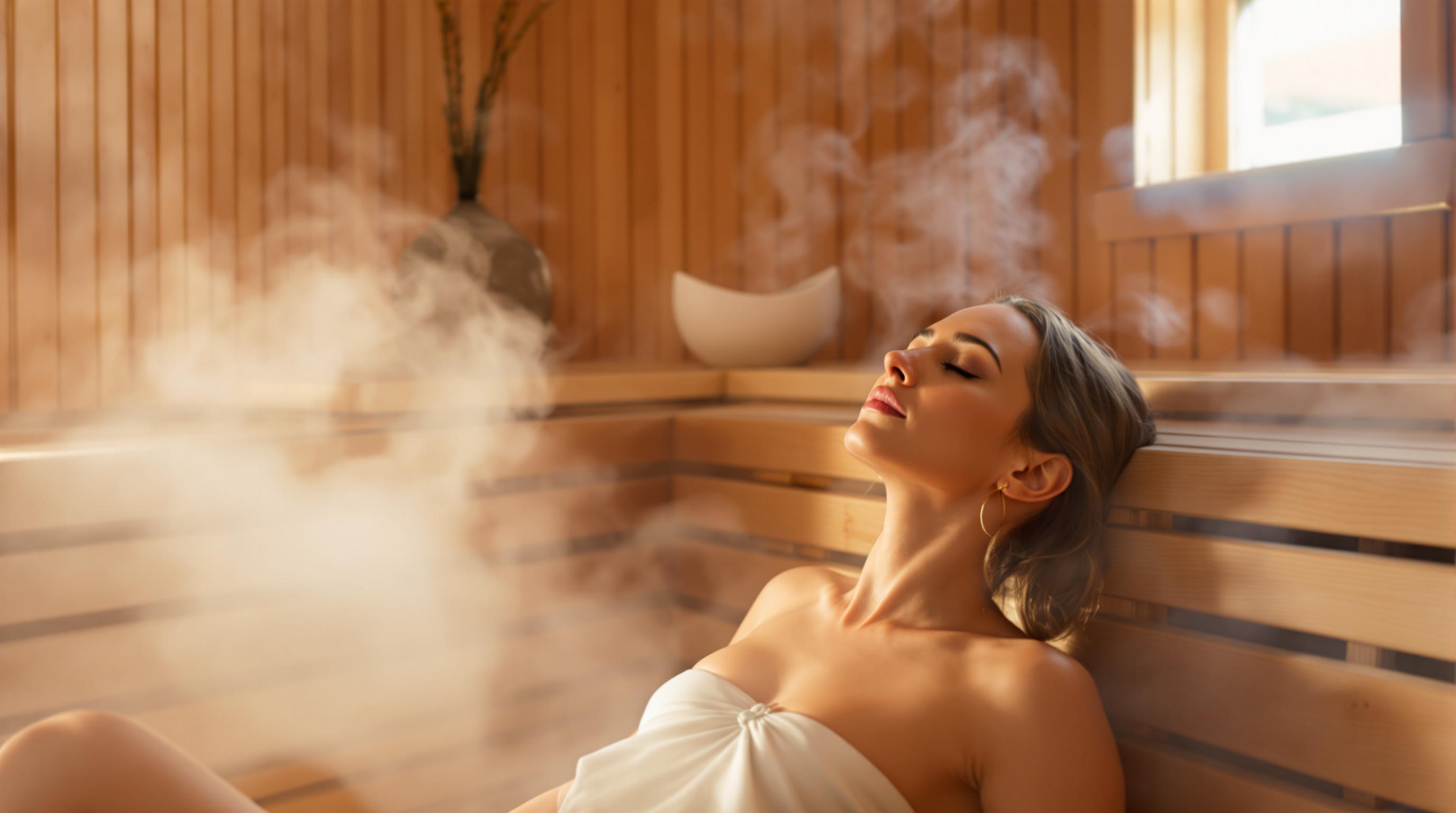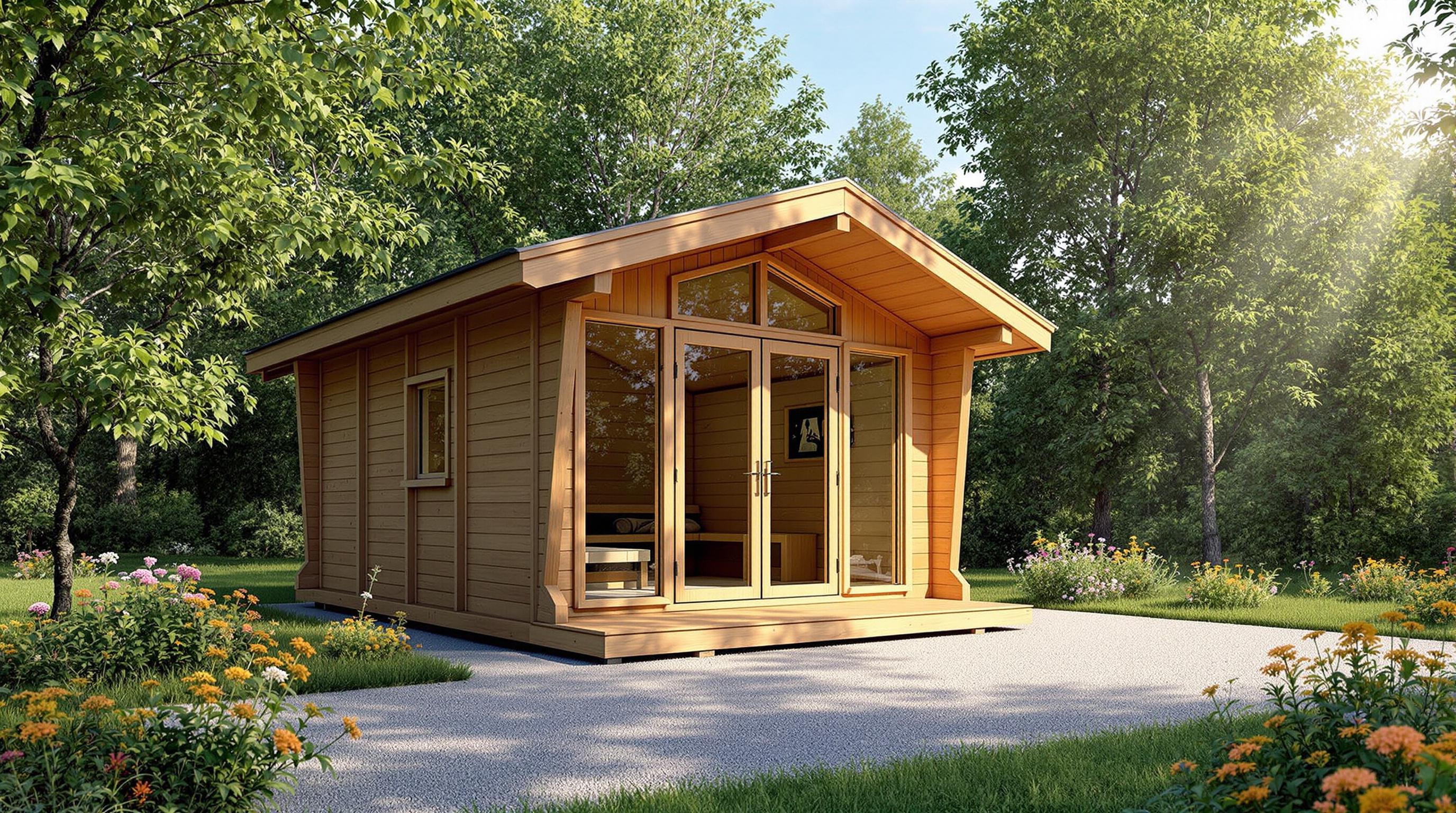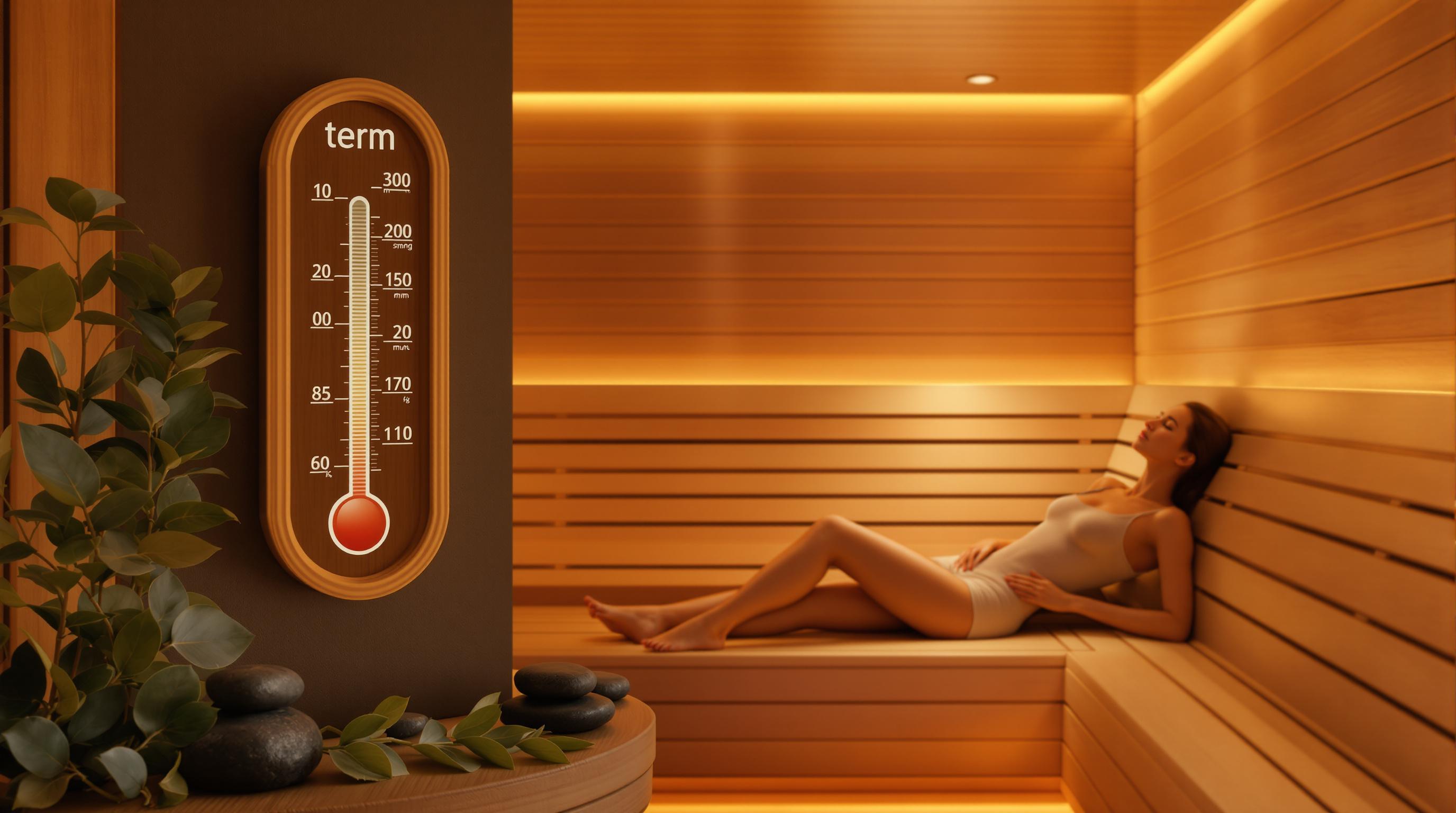-
Why Install a Sauna?
Saunas offer health benefits like better heart health, stress relief, and improved sleep. Plus, they increase property value and make wellness routines more convenient. -
Types of Saunas:
- Infrared: Low energy, targets deep tissues, uses standard outlets.
- Steam: Moderate energy, great for skin and breathing, needs good ventilation.
- Traditional: High energy, classic feel, requires a 220V circuit.
-
Key Setup Requirements:
- Proper ventilation to avoid moisture issues.
- Electrical setup that matches sauna type (licensed electrician recommended).
- Space planning: Allow 20 sq ft per person and at least 7 ft ceiling height.
- Installation Steps:
-
Maintenance Tips:
Regular cleaning, inspect for damage, and schedule annual professional checks.
Quick Comparison of Sauna Types:
| Sauna Type | Heat Source | Energy Use | Key Benefits | Electrical Needs |
|---|---|---|---|---|
| Infrared | IR Heaters | Low | Deep tissue relief, low cost | Standard 110V outlet |
| Steam | Steam Generator | Moderate | Skin and lung benefits | 220V circuit |
| Traditional | Electric/Wood Heater | High | Classic sauna experience | 220V circuit |
Follow this guide to create your personal wellness retreat at home. Let's get started!
Building a Sauna step-by-step
How to Choose the Best Sauna for Your Home
Picking the right sauna means thinking about your space, health goals, and budget. Here's a closer look at what you need to know to make the best choice.
Comparing Infrared, Steam, and Other Sauna Types
Understanding the differences between sauna types is key to finding the one that fits your lifestyle.
| Sauna Type | Heat Source | Energy Use | Benefits |
|---|---|---|---|
| Infrared | IR Heaters | Low | Targets deep tissues, lower costs |
| Steam | Steam Generator | Moderate | Improves skin and breathing |
| Traditional | Electric/Wood Heater | High | High heat, classic sauna feel |
Note: Energy use can vary depending on the model and how often it's used.
Infrared saunas are perfect for smaller spaces and use less energy by heating the body directly. Steam saunas add moisture to the air, which is great for skin and lungs, but you'll need good ventilation to avoid damage from humidity. Traditional saunas offer high heat and a classic feel, making them great for relaxation and cardiovascular health.
Site Requirements: Ventilation and Electrical Access
Your sauna needs proper airflow to avoid moisture problems and the right electrical setup. Infrared models usually plug into standard 110V outlets, but traditional saunas often need a 220V circuit. In all cases, GFCI protection and fresh air intake are essential.
Popular sauna spots include basements, garages, master bathrooms, or outdoor areas with weatherproofing.
Choosing the Right Size and Capacity
The size of your sauna depends on your space and how many people will use it. A good rule of thumb is to allow about 20 square feet of floor space per person.
| Capacity | Recommended Size | Best For |
|---|---|---|
| 1-2 Person | 4' x 4' | Solo use or small spaces |
| 2-3 Person | 5' x 6' | Couples or small families |
| 4+ Person | 6' x 8' or larger | Families or hosting guests |
Don't forget to check ceiling height - most saunas need at least 7 feet for proper heat circulation. Also, factor in space for door swings, maintenance access, and safe distances from walls or other fixtures.
Once you've nailed down the type, location, and size, you're ready to dive into the installation process.
Getting Ready for Sauna Installation
Once you've chosen the perfect sauna and location, it's time to prepare for the installation. This involves gathering the right tools, materials, and setting up the site properly.
Electrical Setup and Safety Guidelines
Electrical work for saunas needs to be handled with care to ensure safety and compliance with regulations. Different sauna types have varying power needs:
| Sauna Type | Power Needs | Requirements |
|---|---|---|
| Traditional | High-power | Dedicated high-capacity circuit |
| Steam | High-power | Dedicated high-capacity circuit |
| Infrared | Standard | Regular household outlet |
All electrical work should be done by a licensed electrician. This ensures safety, meets building codes, and keeps your home insurance valid [2][4].
Tools and Materials You'll Need
Essential Tools:
- Drill, screwdrivers, and a level
- Measuring tape
- Safety gear like gloves and goggles
Key Materials:
- Heat-resistant wood such as cedar or spruce
- Insulation designed to resist moisture
- Vapor barriers
- Proper fasteners
- High-temperature-rated electrical wiring
Preparing the Installation Site
Getting the site ready is crucial for a smooth installation process. Follow these steps:
- Clear and level the area where the sauna will be installed.
- Add moisture barriers if necessary.
- Leave at least 6 inches of space around the installation area.
- Ensure the ceiling height is at least 7 feet.
- Check that the floor is waterproof and can support the sauna's weight [1].
For saunas installed on concrete, make sure the foundation is stable and completely dry before starting [3].
Once the site is prepared and your tools are assembled, you're ready to begin putting your sauna together step by step.
sbb-itb-3953eb0
Step-by-Step Guide to Assembling Your Sauna
With your site ready and tools in hand, it’s time to start putting your sauna together.
Building the Base and Frame
For most saunas, a concrete base works best for stability and durability, but other materials might suit specific models [1]. The base needs to be:
- Level and dry to ensure proper assembly
- Free of debris to avoid uneven surfaces
- Strong enough to hold the sauna’s total weight
- Waterproofed to protect against moisture damage
When constructing the frame, use straight walls and keep a level handy - this is especially important for barrel saunas where misalignment can affect the entire structure [5]. Once the base and frame are done, the next step is insulating and protecting the sauna from moisture.
Adding Walls, Insulation, and Moisture Barriers
Good insulation and moisture protection are key to keeping your sauna efficient and long-lasting. Here's how the layers should look:
| Layer | Material |
|---|---|
| Outer Wall | Cedar or spruce for structural support |
| Insulation | High-temp rated for heat retention |
| Vapor Barrier | 6-mil polyethylene to block moisture |
| Inner Wall | Cedar or spruce for heat resistance |
Place insulation between all stud bays and ceiling joists. After that, install the 6-mil polyethylene vapor barrier to guard against moisture. Finish with cedar or spruce for both the outer and inner walls - these woods handle heat and moisture well [1] [3].
Installing the Heater and Other Features
The heater is a central part of your sauna, so follow the manufacturer’s instructions carefully when mounting it. Ensure proper airflow and safety clearances [1].
- Heater Mounting: Allow enough ventilation space and follow the spacing guidelines provided by the manufacturer.
- Electrical Setup: Refer to the 'Electrical Setup and Safety Guidelines' section for detailed instructions. A licensed electrician should handle the wiring, using high-temp-rated cables in conduit and connecting to a dedicated circuit [2] [4].
- Additional Features:
- Install benches at different heights so users can choose warmer or cooler seating.
- Add heat-resistant lighting fixtures.
- Position controls where they’re easy to reach but still safe [1].
With the heater and other features in place, you’re ready to move on to the final safety checks and finishing touches.
Final Steps and Safety Checks
Checking Electrical and Ventilation Systems
Before firing up your sauna, it's crucial to perform some safety checks. Start with the electrical setup: make sure it adheres to standard requirements, which usually means a 240V/20 Amp circuit paired with 12 gauge wire [4].
For ventilation, here's what you'll need:
- An air intake near the floor to bring in fresh air
- An exhaust vent close to the ceiling to release hot air
- A 1-inch gap under the door for proper air circulation
To confirm everything is working, run the sauna at its maximum temperature for 30 minutes. Look for strong airflow through the vents, check that no condensation builds up on the walls or ceiling, and ensure heat is evenly distributed while moisture is effectively removed [1][3].
Once these systems are in place and functioning, you can move on to finishing and safeguarding the interior.
Sealing and Adding Finishing Touches
Protecting your sauna's wood surfaces is essential. Use a high-temperature waterproof sealant, paying special attention to joints, edges, and mounting points. Install heat-resistant LED lights for ambiance and safety, and add a thermometer/hygrometer combo to monitor temperature and humidity levels. Be sure to position these devices away from direct heat to ensure accurate readings [1][3].
With these steps, your sauna will be ready for use. Now, let's talk about keeping it in top shape.
Maintenance Tips and Common Fixes
Regular care is key to keeping your sauna safe and functional over time. Here's how you can stay on top of it:
Routine Cleaning and Inspections:
- Wipe down benches, floors, and glass surfaces regularly
- Check wood surfaces for signs of moisture damage
- Test temperature controls and safety features
- Ensure ventilation openings are clear and unobstructed
- Inspect electrical connections for wear or damage
Professional Help:
- Schedule a professional inspection annually
- Address ventilation problems quickly to avoid moisture-related issues
- Call a licensed electrician for any electrical repairs or concerns [1][3]
Conclusion: Start Enjoying Your Sauna
Congratulations on setting up your home sauna! With regular upkeep and a focus on safety, your sauna can offer years of relaxation, health perks, and even add value to your property. Now that you've completed the installation, it's time to enjoy the fruits of your effort.
To keep your sauna in top shape, here are a few key tips:
- Manage Temperature: Begin with shorter sessions at lower temperatures (around 150°F) and gradually increase to your preferred heat level.
- Ensure Proper Ventilation: Regularly check airflow during use to maintain good circulation.
- Prioritize Safety: Always stick to the manufacturer's heating and temperature guidelines [1][3].
Your home sauna is more than just a luxury - it's a gateway to better wellness. Whether you're using it for stress relief, recovery, or simple relaxation, proper care will ensure it remains a beloved part of your routine for years to come [1][5].
FAQs
What is the electrical code for a sauna?
The electrical setup for a sauna varies based on its size and type:
- Large saunas: Require a 220-240V dedicated circuit with a 30-60 Amp breaker.
- Small saunas: Can typically use a standard 110-120V circuit.
- All installations: Must use high-temperature-rated wiring and adhere to local building codes [2][4].
Do you need special wiring for a sauna?
Yes, saunas need specific wiring to ensure safety:
- Use wiring rated for high temperatures and moisture.
- Install protective conduits to safeguard the wiring.
- Hire a licensed electrician for professional installation.
- Ensure a dedicated circuit that matches the sauna manufacturer's guidelines [2][4].
Common Electrical Considerations
- Follow the voltage and amperage requirements specified by the sauna manufacturer.
- Verify that your circuit has the capacity to handle your sauna model.
- Install the correct type of outlets based on the sauna's needs.
- Avoid using extension cords under any circumstances [2][4].
A properly installed electrical system ensures your home sauna operates safely and efficiently. Regular safety inspections are a good way to keep everything running smoothly.


